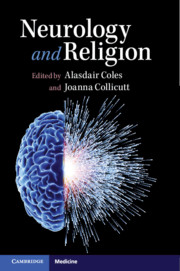Book contents
- Neurology and Religion
- Neurology and Religion
- Copyright page
- Contents
- Contributors
- Preface
- Part I The Neurological Study of Religion
- Part II Neurology and Religion
- II.I Clinical Conditions
- Chapter 9 Temporal Lobe Epilepsy, Dostoyevsky and Irrational Significance
- Chapter 10 Parkinson’s Disease, Religious Belief and Spirituality
- Chapter 11 Beyond Reasonable Doubt
- Chapter 12 Ramadam Fasting and Neurologic Disorders
- Chapter 13 Autism and the Panoply of Religious Belief, Disbelief and Experience
- Chapter 14 Personhood and Religion in People with Dementia
- Chapter 15 Religion and Frontotemporal Dementia
- II.II Therapy
- II.III Death and the Brain
- Bibliography
- Index
- References
Chapter 11 - Beyond Reasonable Doubt
Cognitive and Neuropsychological Implications for Religious Disbelief
from II.I - Clinical Conditions
Published online by Cambridge University Press: 28 October 2019
- Neurology and Religion
- Neurology and Religion
- Copyright page
- Contents
- Contributors
- Preface
- Part I The Neurological Study of Religion
- Part II Neurology and Religion
- II.I Clinical Conditions
- Chapter 9 Temporal Lobe Epilepsy, Dostoyevsky and Irrational Significance
- Chapter 10 Parkinson’s Disease, Religious Belief and Spirituality
- Chapter 11 Beyond Reasonable Doubt
- Chapter 12 Ramadam Fasting and Neurologic Disorders
- Chapter 13 Autism and the Panoply of Religious Belief, Disbelief and Experience
- Chapter 14 Personhood and Religion in People with Dementia
- Chapter 15 Religion and Frontotemporal Dementia
- II.II Therapy
- II.III Death and the Brain
- Bibliography
- Index
- References
Summary
Journal articles and chapters on the cognitive science of religious belief often begin by highlighting the seeming ubiquity of supernatural beliefs (e.g. Pennycook et al. 2012). It is indeed rather striking that most of the world’s population share a similar sort of belief in a deity or greater power. According to Zuckerman (2007), approximately 90 per cent of the world’s population believe in a deity. In 2011, more than 92 per cent of Americans polled by Gallup answered yes when asked ‘Do you believe in God?’ – a number effectively unchanged since 1944 (96 per cent; Gallup 2011). These sorts of observations lead naturally to the conclusion that religious belief must be grounded in common and, perhaps, foundational cognitive mechanisms. We agree, though in this chapter we will instead emphasise religious doubt, a common experience among religious and non-religious alike (Hunsberger et al. 1993). In the same Gallup poll cited above, the number of respondents who answered ‘no’ when asked ‘Do you believe in God?’ increased from 1 per cent in 1944 to 7 per cent in 2011. Moreover, only 80 per cent identified as theists, and 12 per cent identified as deists when asked to distinguish between having belief in a personal God (theism) versus believing in a universal spirit/higher power (deism) in a 2010 poll (Gallup 2011). Finally, in a 2006 version of the same poll, 73 per cent indicated that they were convinced that God exists, with the remainder of the sample indicating some doubt or disbelief (Gallup 2011).
- Type
- Chapter
- Information
- Neurology and Religion , pp. 115 - 129Publisher: Cambridge University PressPrint publication year: 2019



